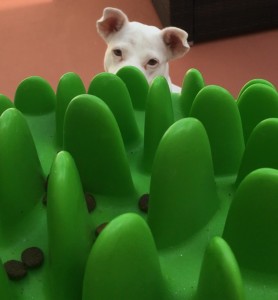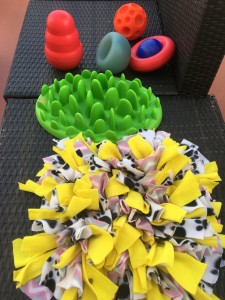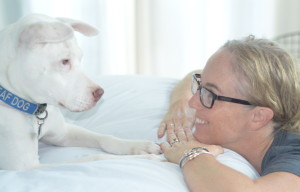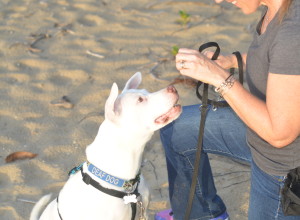Are you struggling with how to begin training your deaf dog?
 You are sitting across from your deaf dog eye to eye thinking, “Ok, now how to get her to understand what I would like?” Bringing a deaf dog into your family doesn’t need to be confusing. In fact it can be lots of fun. And once you have some simple and consistent communication in place it can be quite easy to communicate!
You are sitting across from your deaf dog eye to eye thinking, “Ok, now how to get her to understand what I would like?” Bringing a deaf dog into your family doesn’t need to be confusing. In fact it can be lots of fun. And once you have some simple and consistent communication in place it can be quite easy to communicate!
Often people ask what the first step is when working with a deaf dog. Contrary to what people may think, ASL (American Sign Language) or any other type of sign language is actually step number three!
STEP ONE
The very first step is to develop an effective and efficient method of communication. This means setting up a clear and consistent event marker system. An event marker is a communication tool. Often with hearing dogs the event marker may be a “clicker” which is a small plastic box-type device that makes a “clicking” sound. It may also be a verbal marker such as the word, “yes!”
In the case of a deaf dog, your marker can either be a visual (my preferred method) or a tactile (touch) event marker. I use an “open hand flash” for my visual marker. Some people use a thumbs up or an ASL letter “Y” (for yes).
A marker is a conditioned or secondary reinforcer. This means that it is not inherently reinforcing to the animal. As such, we need to condition it in order for it to have value. The way to do this is to pair the marker with something that the dog likes. Additionally, for the marker to maintain its value it must always be consistently paired. This means that a marker is like a little contract. If you mark, then you must reinforce with something that your dog thinks is valuable. This is an important distinction as sometimes your opinion of a valuable option may not be the same as your dog’s! As a marker is a key piece of communication you always want to keep up your side of the promise by always pairing the marker with something that your dog believes is worthwhile to work for.
The important message is that whichever marker you choose to use, it must be used consistently and should always paired with a valuable reinforcer.
STEP TWO
Once you have established a marker system the next step is to teach a reliable “check in” behavior. A check in enables you to have the dog look to you which then will allow for the opportunity to provide further communication. The way to foster a reliable “check in” behavior is to mark and reinforce each time your deaf dog looks at you. In other words, you are making “looking at you” a worthwhile behavior! Try to begin by practicing the behavior close to your dog and in a very low distracting environment.
Too, at the start, even a quick glance should get a click and then a treat. Working on this piece will also help you to get very quick with your timing skills! Over time you can try practicing some duration with the amount of time your dog will hold your gaze during a check in.
As per the rules of behavior and as noted above, you always want keep in mind the three “Ds” of training. Begin training in the lowest distraction environment, with the shortest duration and with the least distance. Then, build up from there!
STEP THREE
The third step is where I would now encourage teaching additional cues. This is the point at which people may choose to use ASL (American Sign Language) or any other type of visual cue. The important piece when choosing a visual sign for a behavior is to keep it consistent.
To teach new behaviors you will first want to “label” the behavior as it is occurring. This means that while your dog is doing the behavior you would use the sign for this behavior and then mark/reinforce as it is completed.
I suggest repeating this over and over many times before moving the visual cue out to just as your dog is “about” to do the behavior. Eventually, you put the visual cue out in front of the behavior so that you are actually “cueing” it before it happens. This strategy can also keep us from weakening the cue by cueing a behavior repeatedly without the correct response. This sequence of progression allows your dog to associate the visual cue with the action so that they make the connection between the visual cue and the behavior. The marking and reinforcing allow the dog to realize that this behavior is “worth while” and that they should therefore repeat it.
RECAP
To sum it up, you want to condition a marker, teach a “check in,” and then move to labeling and training consistent, and reliable cues! In this way you and your deaf dog can set up an efficient and effective system of communication, which is reinforcing and fun!
For more help, the pocket guide to working with deaf dogs can be found here: https://www.amazon.com/Deaf-Dog-Joins-Family-Communication/dp/1507578261



 Have you recently adopted a deaf dog? Are you confused about just where to start? Would you like some direction as to what to do first?
Have you recently adopted a deaf dog? Are you confused about just where to start? Would you like some direction as to what to do first?
 You are sitting across from your deaf dog eye to eye thinking, “Ok, now how to get her to understand what I would like?” Bringing a deaf dog into your family doesn’t need to be confusing. In fact it can be lots of fun. And once you have some simple and consistent communication in place it can be quite easy to communicate!
You are sitting across from your deaf dog eye to eye thinking, “Ok, now how to get her to understand what I would like?” Bringing a deaf dog into your family doesn’t need to be confusing. In fact it can be lots of fun. And once you have some simple and consistent communication in place it can be quite easy to communicate!